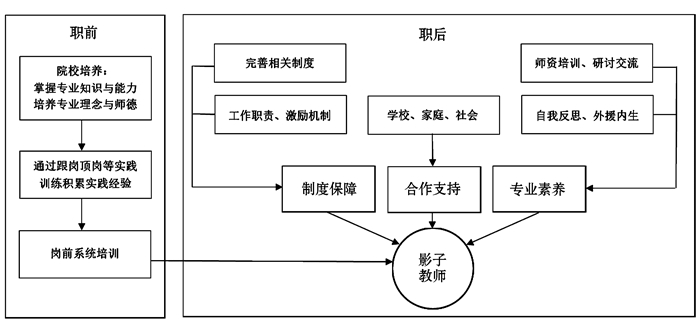-
20世纪50年代初,美国出现师资匮乏的状况,学校首次引进影子教师为学生提供教育服务,影子教师应运而生。随着特殊教育的不断发展,教育者发现在特殊教育实践过程中,一些特殊儿童的障碍程度较重,个体的异质性较大,可能在课堂中出现各种突发状况,从而扰乱课堂秩序,而授课教师的时间和精力有限,很难兼顾全面,也难以满足所有学生的个别化需求,由此导致整个班级的教育教学质量受到影响。为缓解这一问题,影子教师作为支持者被引入特殊教育场域,并扮演了重要角色。相关数据显示,2011年,美国特殊教育影子教师的数量已经超过45万人[1]。影子教师自诞生以来,经过数十年的发展,不仅在数量上、规模上大幅度提升,其角色也从开始的单一走向如今的多元。
影子教师又称教育辅助人员、陪读教师、辅助教师等,在我国台湾地区也被称为教师助理员。在《特殊教育辞典》中,对于“影子教师”的定义为:经过训练的一种专业人员,可以包括家长,在特殊教育领域充当课堂助手的角色,以援助教师进行课堂教学[2]62。另有研究者指出,影子教师是指协助身心障碍学生学习及生活的人员[3]。不同地区对于影子教师的称谓不同,但无论其称谓如何变化,影子教师已经成为为特殊儿童提供支持保障的关键角色。美国学者费舍尔(Fisher)指出,影子教师是K-12教育体制下特殊需要学生的主要支持来源,特殊需要学生的成功在许多方面取决于影子教师的支持[4]。概括来说,影子教师是具有一定特殊教育知识和技能的,在学校里配合授课教师的教学与管理、辅助特殊儿童的学习与生活、帮助并促进特殊儿童适应学校教育的主体。
已有相关研究表明,影子教师的介入对于促进特殊教育的发展起着重要作用。本研究旨在对当前国外影子教师的角色定位进行梳理,把握影子教师的发展脉络,归纳其目前面临的发展困境,丰富该领域的理论,为我国特殊教育、融合教育师资的培养和发展及相关研究提供参考与借鉴。
全文HTML
-
在学校场域,影子教师以特殊儿童为中心,与其他教师、学生、家庭、社区等协同合作,形成了较为完整的特殊儿童学校支持服务体系,共同服务于特殊儿童。影子教师既围绕特殊儿童的需求开展工作,也在学校其他人员、教师以及社区等服务于特殊儿童的人员中发挥衔接作用。笔者通过梳理国外已有相关文献,归纳总结出国外特殊教育影子教师主要扮演了以下几种角色。
-
影子教师最核心的工作之一为辅助教学,即与班级授课教师或资源教师进行合作,在课堂中指导特殊儿童参与学习,以此提高教学成效[5]。笔者所收集的文献中关于影子教师角色的表述无一例外地涉及其辅助教学的作用。詹格雷科(Giangreco)等学者通过对12所融合教育学校中的影子教师进行调查研究,发现其中70%的影子教师表示他们同普通教师一起,参与到了课程与教学活动的决策当中[6]。这表明,影子教师不仅是融合教育环境中的重要支持者,同样也是具有专业水平的、能够参与教育教学事务的教学辅助者。哈里斯(Harris)通过多案例研究法,对融合教育背景下视障学生与影子教师间的关系进行研究,结果表明,聘用影子教师的主要原因在于提升特殊儿童的教育成效,影子教师通过参与课程设置、执行与支持,辅助授课教师教学,帮助视障学生获取知识[7]。总的来说,由于各地学校资源教师的配备数量有限,而接受教育的特殊儿童逐渐增多,且程度、需求各不相同,教师们很难兼顾每个特殊儿童,影子教师可以配合其他教师,在一定程度上较好地满足特殊儿童的需求。影子教师与其他教师之间行之有效的专业关系与默契配合,对于特殊儿童获得高质量的教育至关重要[8]。
-
特殊儿童需要经过科学的诊断与评估,教育团队再根据评估结果为其制订个别化教育计划(IEP)并付诸实施。但特殊儿童可能会因为各方面原因不能完全跟上课堂节奏,因此仅在班级中参与集体授课是不够的。在整个教育教学过程中,影子教师都需要整合资源,对课程、材料、活动等进行大量的调整与修改,并在课后对特殊儿童进行补充教学,以满足其个别化需求[9]。此外,影子教师还需要对特殊儿童进行缺陷补偿与潜能开发,通过额外的教学,采取针对特殊儿童有效的教学策略,提高特殊儿童的教育质量。戈特弗里德(Gottfried)等研究者指出,影子教师的补充教学充分体现了以儿童为中心的理念,其根据儿童的需求、以儿童为主体,实施课堂之外的补充教育,使特殊儿童受益[10]。通过已有的实证研究可知,影子教师提供的个性化支持对提升特殊儿童的学习成效非常有效,能够弥补因授课教师在课堂教学中无法专注于所有学生而导致的不足。影子教师在课后基于特殊儿童的个体差异,一方面对其所学内容进行查漏补缺,另一方面对其感兴趣的内容展开补充教学,以培养其对学习的主动性和兴趣,使其各学科的学习尽可能达到均衡水平。影子教师为特殊儿童提供的课后个别化教育、补充学习,既能使特殊儿童的需求得到满足,也在一定程度上减轻了授课教师的负担。
-
特殊儿童特别是孤独症谱系障碍者、智力障碍者等,常会伴有情绪行为问题,缺乏规则意识,在课堂中时常会表现出与课堂要求和规则不相符、影响课堂纪律的行为,如离座、拍手、转圈、自伤、攻击性行为等。这些行为或多或少会扰乱班级秩序、打断教学进程、影响其他同学。同时,这些行为的产生也会导致教师、学生以及家长对特殊儿童参与融合课堂的态度受到影响。而影子教师与特殊儿童能够零距离相处,可以及时地对特殊儿童的问题行为进行观察与矫正,分析其背后的原因和变化,并迅速实施干预。多项研究表明,影子教师能够及时地监管特殊儿童,控制其问题行为,对于其情绪给予及时安抚,并在必要时将其带离教室,以避免干扰其他同学,影响教学质量。此外,除了在课堂上对特殊儿童的行为进行监管,影子教师还加入到了对特殊儿童的问题行为进行矫正的队伍当中,或参与特殊儿童的康复训练。研究者罗宾逊(Robinson)采用多基线实验设计,探究影子教师在融合教育环境中,对孤独症谱系障碍儿童实施关键反应训练(Pivotal Response Treatment,简称PRT),以提高其社交与沟通能力,结果表明,影子教师的参与使得干预过程行之有效[11]。影子教师通过与特殊儿童的密切接触,能够充分发挥其熟悉与了解特殊儿童的优势,训练特殊儿童养成自我控制、自我强化的习惯,扮演着特殊儿童情绪行为监管与干预的重要角色。
-
部分残障程度相对较高的特殊儿童生活不能自理,影子教师承担了其学校日常生活照料者的角色,职责包括护理与照料,如指导特殊儿童就餐、协助特殊儿童如厕、帮助需要日常服药的特殊儿童按时用药、维护特殊儿童上下学过程中的安全等。学者路易斯(Lewis)和麦肯齐(McKenzie)采用问卷调查法,在美国各州随机选取138名融合教育学校中的影子教师作为调查对象,对其工作内容进行调研,结果显示,51%的受访者表示花费了大量时间用于照顾特殊儿童的日常起居和训练特殊儿童的生活技能[12]。从已有研究可知,日常生活有序是特殊儿童融入学校所必需的条件,但是有的特殊儿童由于障碍程度较高影响到日常生活,进而对其参与普通教育造成一定的不便和困扰。影子教师除了在一定程度上为校园生活不能自理的特殊儿童解决困难之外,还能有计划、有目的地训练特殊儿童的生活自理能力,帮助他们学会自我管理,掌握自理技能,并逐渐能独立完成个人护理、养成良好的生活习惯,同时促使他们能更好地融入班级、融入学校、融入社会。
-
影子教师全天负责特殊儿童的学业及其他所有需求,与特殊儿童相处时间最长、接触最密切,因而可利用其对学生的充分了解,发挥沟通者与衔接者的作用。其衔接者这一角色在学校场域内外都发挥着重要作用。第一,影子教师在教育团队中与其他教师沟通合作。弗兰奇(French)通过访谈18组相互配合的授课教师与影子教师,发现影子教师如何与特殊教育教师、通识教育教师和其他相关专业同事建立合作关系尤为重要[13]。第二,影子教师与家庭沟通联系,推动家校合作。有的影子教师在与特殊儿童家庭相处的过程中,与特殊儿童家长建立起了良好的友谊,并自称为“家庭朋友”[14]。乔普拉(Chopra)等通过对特殊儿童家长及影子教师进行深度访谈,发现影子教师与家长几乎每天都会进行沟通,其关系越来越密切,并逐渐形成默契与合力,这有利于儿童的发展[15]。肖赫(Sheehey)等研究者发现,影子教师与特殊儿童家庭建立联系,能使家长与学校形成合力,促进家庭与学校间的信任发展[16]。第三,影子教师也促进了特殊儿童与同学间的互动,能帮助特殊儿童更好地融入学校。布洛克(Brock)等学者采用单一被试实验法对4组影子教师指导普通儿童支持特殊儿童学习进行研究,发现影子教师指导实施同伴支持可以改善特殊儿童的学习效果,发展同伴关系[17]。此外,影子教师还能发挥对融合教育的宣介作用,通过与社区等机构开展合作,建立良好的合作关系,共同推动特殊教育、融合教育的发展。
一. 融合课堂教育教学的辅助者
二. 特殊儿童课后学习的助力者
三. 特殊儿童情绪行为问题的矫正者
四. 特殊儿童日常生活的照料者
五. 学校场域内外的衔接者
-
教师队伍的质量直接关系教育的改革与发展。通过已有文献得知,国外特殊教育影子教师无论是在自身权利、专业发展还是工作环境等方面都面临困境。
-
通常情况下,影子教师可能是教师,也可能是家长、志愿者,其工作虽具有“教育性”,但并不具备法律意义上的教师资格与身份,因此,角色定位不清晰造成了影子教师角色的模糊与分工的不明确,导致影子教师承担过多的工作,使其他人员对其角色产生误解,甚至为其贴上“打杂”的标签,认为其是非专业化的。职业身份边缘化所导致的一连串问题,使影子教师承受着来自多方面的压力,其心理状态也因此受到很大影响,并进而影响到工作效率。已有国际研究证实了影子教师角色无定形性质所带来的负面影响,认为缺乏对影子教师角色和职责的明确界定以及影子教师就职细节的文本等,进一步说明了这一职业的边缘化,也意味着影子教师甚至没有真正被看作教育系统中的一部分[18]。瑞格斯(Riggs)和穆勒(Mueller)对影子教师的经历进行了研究,在关于工作职责方面,大约有一半的受访者表示从未获得过正式的、成文的工作职责说明;少部分受访者表示有工作说明,但“说明”并不能完全涵盖当前的工作职责;只有极少数受访者表示了解自己作为一名教育工作者的角色分工,且文件与当下的工作吻合[19]。还有学者指出,没有相应的政策文件详细规定影子教师的职业角色,这种角色的含糊不清导致影子教师承担过多的角色任务,如整个班级的管理、辅助整个班级的教学等,使其任务繁杂、负担增加[20]。
-
影子教师在教育教学过程中,承担了诸如提供学习和社交技能指导、参与课程调整、管理学生情绪行为、与他人建立工作关系、促进融合教育发展等一系列十分重要的工作[21]。弗兰克(Frank)等学者的研究也表明影子教师需要具备多方面的能力,以应对不同的教学模式以及所服务学生的个体差异[22]。然而,有研究表明,影子教师的专业培训相对缺乏,且培训并不精准,往往泛泛而谈。相关学者的研究结果显示,在特殊教育的教师团队中,影子教师所接受的培训是最少的,已有的培训也大多内容零散,并没有精准地针对其发展需求[23]。马萨夫拉(Massafra)通过调查发现,尽管参加了正规培训,影子教师仍然表示自己的专业能力缺乏,接受的监管也不足[24]。另有研究者通过访谈发现,绝大多数的受访影子教师都认为缺乏培训和专业发展的机会:一方面,影子教师虽然接受了少量的培训,但是培训内容并没有针对工作中的实际需求,更多是流于表面、流于形式;另一方面,影子教师希望对学生负责,想要努力提升自己的专业素养,但相关管理部门对影子教师及其需求缺乏关注,造成影子教师“有心无力”[25]。
-
学校工作人员之间建立有效的专业关系,对于为特殊儿童提供高质量的教育体验至关重要。然而,国外部分特殊教育影子教师与其他教师的协同合作状况不容乐观,同时影子教师也缺乏相关督导者支持其工作。谢曼(Shyman) 采用量化研究的方法对影子教师的情绪进行预测因素探究,通过抽样调查确定了影子教师情绪衰竭水平及与之相关的因素,同时通过回归分析得知,同行的支持是影子教师情绪的重要影响因子,证明团队协作对影子教师的情绪有着重要的影响[26]。沃兹沃思(Wadsworth) 和奈特(Knight)的研究表明,部分影子教师在工作中焦虑情绪严重,而这种情绪主要源自于教育团队中成员间缺乏有效的合作,受访影子教师表示,无论是班级授课教师还是特殊教育教师,都希望影子教师能将特殊儿童的所有事务都处理好,但是“当我请老师提供儿童的相关材料时,他们却似乎常常无视我的需求”[27]。这表明,一方面,其他教师想要安排更多的事务给影子教师,另一方面,这些教师却并没有为影子教师提供相应的支持与帮助。
一. 定位模糊分工混淆
二. 专业发展受限
三. 协同合作流于形式
-
近年来,国外相关部门以及科学研究已着眼于影子教师的困境与诉求,开始重视影子教师的队伍建设与发展问题。
-
国家制度是保障和促进教师专业发展的政策法规,是教师专业发展的重要制度环境[28]。为解决上述提及的影子教师的角色模糊问题,西方发达国家如美国出台的《残疾人教育法修正案》(Individuals with Disabilities Education Act Amendments,简称IDEA法案)、《不让一个孩子掉队法案》(No Child Left Behind Act,简称NCLB)、《让每一个孩子成功法案》(Every Student Succeeds Act,简称ESSA)等,都对特殊教育影子教师的角色定位以及职业分工进行了明确规定,以确保影子教师的角色清晰、工作条理化,从而在一定程度上避免了影子教师职业身份边缘化的问题。美国IDEA2004法案在第四部分“国家为提高特殊教育水平而采取的行动”(National Activities to Improve Education of Children with Disabilities)中,专门对特殊教育师资的录用与分配进行了详细规定:无论是特殊教育教师还是相关服务人员、辅助人员,都属于特殊教育团队成员,都需获得国家批准或承认的证书、执照等,以确保其具备为特殊儿童服务的知识和技能,能各司其职,提供特殊教育及相关服务[29-30]。相应的制度法案,厘清了影子教师的职能,有效缓解了影子教师的边缘化问题。
-
为解决特殊教育影子教师专业发展受限问题,相关地区构建了影子教师终身学习体系,通过精准有效的培养培训促进影子教师的专业发展。有研究者提出,当地可将已就职影子教师的职业需求和培训期望与影子教师当下或曾经所接受的实际培训进行比较分析,以确定培训内容是否合理、是否全面,是否能够涵盖影子教师的工作期望,并以此评价结果作为改进标准,完善培训机制与内容,实施真正能够破解影子教师工作难题、满足其工作需求的培养培训[22]。此外,相关部门还呼吁影子教师与其他教师开展深度合作,定期举办针对特殊儿童教学的研讨会议,共同探讨教学团队中各个成员的角色,这样能够最大程度地减少误会,共享学生信息,灵活调整教学方案[31]。另有研究者认为,“开放包容、相互尊重、共同以学生为中心”是理想教育团队的合作要素[32]。同样,部分国家和地区在政策法规中也指出,包括影子教师在内的所有提供特殊教育服务的工作者,都需要接受适当的职前、职后培训,以更好地应对工作需要。
-
为提高师资团队合作效益,国外相关法案明确指出或强烈暗示了协作的重要意义,强调教育团队所有成员应共同对学生的学习生活负起责任[33],指出特殊教育团队中,影子教师、特殊教育教师、通识教育教师以及管理人员(包括校长、特殊教育主任、领域专家等)应协同合作。其中,管理人员对团队工作起着重要的枢纽作用——管理人员对包括影子教师在内的所有团队成员的日常工作进行监督,对教师的工作成效进行评估,对相关工作的实施进行规划与指导。道格拉斯(Douglas)等研究者通过对数名影子教师进行访谈,了解其与教师团队的合作状况以及外界的督导情况,结果显示,协同与督导流于形式的问题已有所改进。访谈中大多数受访者表示,其工作越来越能够得到行政部门、专家团队以及其他教师的大力支持,团队合作效益日益增长,团队成员间能相互尊重、保持密切联系,同时,管理人员也定期参与会议,共同解决困难与挑战[34]。
一. 出台制度厘清职能
二. 构建终身学习体系
三. 加强队伍管理和督导
-
西方发达国家开展特殊教育的时间较长,在影子教师的发展与实践方面积累了一定的经验,研究成果也不断丰富,并逐渐走向体系化、规范化。而我国大陆地区的特殊教育特别是融合教育实践还处于发展初期,“随班就坐”“随班混读”等现象并不少见。究其原因,除了教师本身的专业性不足以外,缺乏影子教师等支持保障系统是重要因素。学习、借鉴国外相关经验,有助于促进影子教师发展的本土化探索与实践。
-
教育现代化背景下,需要高水平、高素质的专业教师,国际教育改革已将教师的专业化提升作为极其重要的任务。基于当前特殊教育发展状况,培养兼具普通教育和特殊教育专业背景的融合教育师资,应是特殊教育师资培养未来改革的方向与目标。当下,我国承担特殊教育影子教师这一职责的人员背景多样,既有特殊儿童家长、雇佣的保姆,也有专业人员、志愿者等,不少所谓的“影子教师”缺乏专业的特殊教育背景。此外,我国影子教师工作尚未体系化、制度化,并未单独设立“影子教师”这一工作岗位,导致此项工作缺乏专业性与规范性,任职人员对于职责的认知模糊不清,教育团队中的其他成员对其持有偏见等。影子教师不仅是一项职业,更是一门专业,是特殊教育团队的中坚力量。他们与特殊儿童在校期间接触时间最长,担负着教学、康复、育人等多重任务,与其他相关方密切合作能够有效助力特殊儿童个体的发展。从国外发达国家影子教师的发展实践可知,其专业化要求不断提高,我国应当对这一岗位进行系统规划,同时根据本土特殊教育现状以及学生需求,合理设置影子教师岗位,逐步完善特殊教育支持保障体系。
-
通过文献分析可知,西方发达国家已经出台影子教师相关规定,包括任用、职责、遴选规则、程序、报酬等方面。借鉴其经验,职能部门首先应出台与影子教师相关的政策条例,明确影子教师的角色分工与工作职责。通过权威政策文本,对影子教师的工作内容进行明确界定,避免出现角色模糊与错位问题,使影子教师的工作开展能够有章可循、有据可依。此外,还应尽快建立合理有效的影子教师审查机制,提高影子教师队伍的专业化程度,通过建立完善的人事录用制度,规范影子教师的入职程序。财政部门等要着力提高影子教师的工资水平,明确影子教师最关心的切身利益,有针对性地提出编制与薪资酬劳的具体优化措施,充分激发影子教师的工作积极性。同时,建立合理的激励机制,增强影子教师的自我效能感与满足感。此外,影子教师的工作内容繁杂,设立影子教师管理与监督专职部门,对其日常工作进行督导,可有效提高其工作效率,同时也能对影子教师起到一定的约束作用。通过上述措施,完善影子教师的制度体系,为影子教师的专业发展和合法权利提供制度保障,同时约束、监管、规范其工作。
-
当前,我国影子教师教育领域存在两大普遍性问题:一是培养培训缺位;二是职前培养与职后培训相互分离、断层。借鉴国外相关经验,基于我国教师培养培训一体化与终身学习理念,笔者提出特殊教育影子教师发展与支持模式(如图 1所示),以提高影子教师职业素养,规范影子教师教育体系。在影子教师职前培养阶段,师范院系应制订系统、专业的培养方案,以增进学生的职业理解与认同感,使其对特殊教育有全面而清晰的认识,通过理论学习,掌握特殊教育相关知识,能应对特殊儿童的差异性与复杂性。同时,注重职前实践技能培养,安排见习、实习活动,通过跟岗、顶岗了解影子教师的角色定位及其主要职能。此外,随着融合教育的不断发展,为促进普特融合,在影子教师职前阶段既要重视特殊教育知识与技能的培养,又要将普通教育放在重要地位。入职前,各级教育职能部门或基层学校应针对新入职影子教师安排系统的岗前培训,对职前教育与职后培养进行有效衔接,使新晋影子教师能够尽快实现身份转变。入职后,为确保影子教师的专业质量,相关部门应定期组织培训,且培训应理论与实践相结合,不仅内容全面,而且形式多样,不仅有理论学习,更有实操演练,使影子教师的工作能力与人文素质都能得到真正发展,进而增强专业能力和从业信心,最终得以灵活应对不同特殊儿童的多样化需求。
-
我国2012年出台的《关于加强特殊教育教师队伍建设的意见》提出,“营造关心和支持特殊教育教师队伍建设的浓厚氛围。加大优秀特殊教育教师的宣传力度,在全社会大力弘扬特殊教育教师的人道主义精神和奉献精神”[35],同时强调了营造“尊师重道”“包容接纳”文化氛围的重要性。特殊教育的高质量发展离不开全民的支持、离不开文化的作用,同样,影子教师的发展也离不开外界在物质和精神上提供的支持与帮助。不仅如此,和谐的工作关系还会给团队成员带来归属感与安全感,满足教师日常交际需要,同时激发其工作的积极性。因此,应创建协同合作机制,让影子教师与学校、家庭、社会形成合力,通过多方联动,共同促进特殊儿童的发展。首先,学校应营建一种平等的同事关系。影子教师与其他教师属于长期社会性关系,其关系好坏直接影响特殊教育工作质量。教师团队应合理分配工作职责,定期召开联席会议,管理人员与部门要对影子教师工作进行监督与指导。其次,学校与家庭应开展有效合作。学校教育是家庭教育的延伸,家长应配合学校的教育教学工作,并参与到教育团队当中,及时与影子教师及其他教育人员进行沟通交流;影子教师也应充分信任家长,与家长通力合作,提高工作成效。最后,社会形成融合的文化氛围。影子教师需要与社区、残联、民政等组织与部门通力合作,帮助特殊儿童走出家庭、走进社会,逐步实现融合。在接纳、尊重、包容的社会风气之下,大众对影子教师角色的理解与认同、对特殊教育的支持与帮助,将是影子教师专业发展的持久动力,更是发展高质量特殊教育的动力源泉。




 下载:
下载: